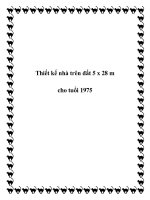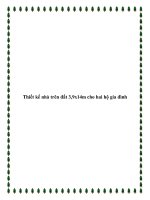Seismic design EC8 Thiết kế chống động đất
Bạn đang xem bản rút gọn của tài liệu. Xem và tải ngay bản đầy đủ của tài liệu tại đây (3.83 MB, 58 trang )
Seismic Design of New R.C. Structures
Prof. Stephanos E. Dritsos
University of Patras, Greece.
Pisa, March 2015
Seismic Design Philosophy
Main Concepts
Energy dissipation
Ductility
Capacity design
Learning from Earthquakes
Energy Dissipation
3
Ductility and Ductility Factors
•
Ductility is the ability of the system to undergo plastic deformation. The
structural system deforms before collapse without a substantial loss of
strength but with a significant energy dissipation.
• The system can be designed with smaller restoring forces, exploiting
its ability to undergo plastic deformation.
• Ductility factor (δu/δy): Ratio of the
ultimate deformation at failure δu to the
yield deformation δy.
* δu is defined for design purposes as the
deformation for which the material or
the
structural
element
loses
a
predefined percentage of its maximum
strength.
4
Ductility Factors
δu
µδ =
δy
δu: ultimate deformation at failure
δy: yield deformation
• In terms of rotations:
(for members)
θu
µθ =
θy
θu: ultimate rotation at failure
θy: yield rotation
• In terms of curvatures:
(for members)
ϕu
µϕ =
ϕy
φu: ultimate curvature at failure
φy: yield curvature
• In terms of displacements:
5
Behaviour q Factor
The q factor corresponds to the reduction in the level of seismic
forces due to nonlinear behaviour as compared with the expected
elastic force levels.
Ductility and Behaviour Factor q
Vel .
Definition q =
Vinel
Flexible Structures T ≥ Tc : Rule of equal dispacement
V1max δ u 2
=
= = µδ
q
V2max δ y 2
δy2
δu2
δ
7
Ductility and Behaviour Factor q
Stiff Structures T≤Tc
for T=0 q=1
for T=Tc q=μδ
q
μδ
1
δy
δu2
Rule of equal dissipating energy
q
Vel V1max
=
= (2 µδ − 1)1/ 2
Vinel V2max
δ
Τc
Τ
T
q=
1 + ( µδ − 1) (Eurocode 8)
Tc
8
Design spectrum for linear analysis
• The capacity of structural systems to resist seismic actions
in the non-linear range permits their design for resistance
to seismic forces smaller than those corresponding to a
linear elastic response.
• The energy dissipation capacity of the structure is taken
into account mainly through the ductile behavior of its
elements by performing a linear analysis based on a reduced
response spectrum, called design spectrum. This reduction is
accomplished by introducing the behavior factor q.
9
Design spectrum for linear analysis (Eurocode 8)
• For the horizontal components of the seismic action the design spectrum, Sd(T),
shall be defined by the following expressions:
ag is the design ground acceleration on
type A ground (ag = γI.agR); γI=importance
factor
TB is the lower limit of the period of the
constant spectral acceleration branch;
TC is the upper limit of the period of the
constant spectral acceleration branch;
TD is the value defining the beginning of
the constant displacement response
range
of the spectrum;
S is the soil factor
Sd(T) is the design spectrum;
q is the behaviour factor;
β is the lower bound factor for the
horizontal design spectrum,
10
recommended β=0,2
Importance Classes (Eurocode 8)
11
Behaviour Factor (Eurocode 8)
• The upper limit value of the behavior factor q, introduced to account
for energy dissipation capacity, shall be derived for each design
direction as follows: q = qo∙kw ≥ 1,5
Where qo is the basic value of the behavior factor, dependent on the type
of the structural system and on its regularity in elevation;
kw is the factor reflecting the prevailing failure mode in structural systems
Pr evailing wall aspect ratio =
Σhwi / Σ wi
(1 + ao ) / 3 ≤ 1 and ≥ 0,5 ao =
with walls: ku =
• Low Ductility Class (DCL): Seismic design for low ductility , following
EC2 without any additional requirements other than those of § 5.3.2, is
recomended only for low seismicity cases (see §3.2.1(4)).
12
Behaviour Factor (Eurocode 8)
A behaviour factor q of up to 1,5 may be used in deriving the seismic
actions, regardless of the structural system and the regularity in elevation.
• Medium (DCM) and High Ductility Class (DCH):
For buildings which are not regular in elevation, the value of qo should be
reduced by 20%
13
au/a1 in behaviour factor of buildings designed for ductility:
due to system redundancy & overstrenght
Structural Regularity (Eurocode 8)
• For seismic design, building structures in all modern codes are
separated in two categories: a) regular buildings
b) non-regular buildings
• This distinction has implications for the following aspects of the seismic
design:
− the structural model, which can be either a simplified planar model or
a spatial model ;
− the method of analysis, which can be either a simplified response
spectrum analysis (lateral force procedure) or a modal one;
− the value of the behavior factor q, which shall be decreased for
buildings non-regular in elevation
15
Structural Regularity (Eurocode 8)
16
Criteria for Regularity in Elevation (Eurocode 8)
• All lateral load resisting systems, such as cores, structural walls, or
frames, shall run without interruption from their foundations to the top
of the building or, if setbacks at different heights are present, to the
top of the relevant zone of the building.
• Both the lateral stiffness and the mass of the individual storeys shall
remain constant or reduce gradually, without abrupt changes, from the
base to the top of a particular building.
• When setbacks are present, special additional provisions apply.
17
STRUCTURE OF EN1998-1:2004
How q is achieved?
• Specific requirements in detailing (e.g. confining actions by
well anchored stirrups)
• Avoid brittle failures
• Avoid soft storey mechanism
• Avoid short columns
• Provide seismic joints to protect from earthquake induced
pounding from adjacent structures
• …..
Material limitations for primary seismic elements“
Capacity Design
Avoid weak column/strong beam frames
Capacity Design
Provide strong column/weak beam frames or
wall equivalent dual frames, with beam sway
mechanisms, trying to involve plastic hinging at
all beam ends
Capacity Design (Eurocode 8)
column 1
beam 1
beam 2
column 2
Exceptions: see EC8 §5.2.3.3 (2)
Shear Capacity Design (Eurocode 8)
Avoid Brittle failure
∆Μ
V=
M
M
∆x
2
1
M 2 − Μ1
V=
Column moment distribution
12
2
1
+
+E
1
M1,d
1
-E
-
M1,d
-
+
or
2
Vmax,c
-
M2,d
M 1,+d + Μ −2,d
, 12 clear
=
12
+
Vmax,c = −
2
+
M2,d
M 2,+ d + Μ1,− d
12
Shear Capacity Design of Columns (Eurocode 8)
+
M1,d
γRd·MRc,1+ , when ΣΜRb > ΣΜRc ,
weak columns
γRd·MRc,1+ ·(ΣΜRd,b\ ΣΜRd,c) , when ΣΜRb < ΣΜRc , weak beams:
(moment developed in
the column when beams fail)
Similarly
-
M1,d
γRd·MRc,1- , when ΣΜRb < ΣΜRc
γRd·MRc,1- ·(ΣΜRd,b\ ΣΜRd,c)
Also similarly for M2,d+, M2,dΣΜRb , ΣΜRc for the corresponding direction of seismic action (+E or -E)
• In DC H γRd=1.3
• In DC M γRd=1.1









